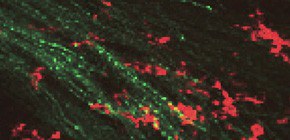
Highlighting the role of immune cells in the survival of motor neurons in the brain
As part of JST's basic research programs, under the leadership of Professor Toshihide YAMASHITA , and former Assistant Professor Masaki UENO *, Graduate School of Medicine, Osaka University, and FUJITA Yuki , Specially Appointed Assistant Professor, a group of researchers discovered that microglia that had been thought as immune cells involved in repairing the brain were also involved in the survival of motor neurons.
Microglia are immune cells with diverse functions in physiological and pathological conditions such as repairing brain tissues during disease; however, their role during the brain development period had been unknown. In order to clarify the role of microglia during brain development, using inhibitory drugs and genetically-engineered mice in order to suppress microglia activity, this group succeeded in observing brain activity and development. As a result, this group found that apoptosis could be selectively induced to motor neurons.
This group demonstrated for the first time in the world that a function of microglia was to protect certain neurons and clarified that microglia-derived IGF1 (inslin-like growth factor) was related to neuronal survival.
This group's achievement also clarified a new mechanism for maintaining neural circuits and neurons during the mammalian development period. Making use of survival effects of microglia will lead to possible development of new therapeutic methods for cranial nerve diseases such as amyotrophic lateral sclerosis (ALS).
*Dr. Ueno currently serves as a researcher at the Cincinnati Children's Hospital Medical Center, Ohio, USA
Abstract
Neurons require trophic support during neural circuit formation; however, how the cellular milieu contributes to neuronal survival remains unclear. We found that layer V cortical neurons require support from microglia for survival during postnatal development. Specifically, we found that microglia accumulated close to the subcerebral and callosal projection axons in the postnatal brain. Inactivation of microglia by minocycline treatment or transient ablation of microglia in CD11b-DTR transgenic mice led to increased apoptosis, specifically in layer V subcerebral and callosal projection neurons. CX3CR1 in microglia was required for the survival of layer V neurons. Microglia consistently promoted the survival of cortical neurons in vitro. In addition, we identified microglia-derived IGF1 as a trophic factor that maintained neuronal survival. Our results highlight a neuron-glia interaction that is indispensable for network formation during a specific period in the developing brain.

Figure 1

Figure 2

Figure 3
To read the full research report entitled "Layer V cortical neurons require microglial support for survival during postnatal development , " please go to this page at the Nature Neuroscience website.
Related link :
